Walking with wildlife -- Chicago's "go-to-guy" on nature
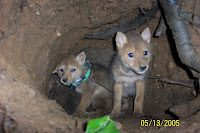
(POSTED: 10/5/09) At first blush, Chris Anchor's job sounds a little like that of a police detective.
The late nights, the stakeouts, 60-plus-hour work weeks, even the occasional threatening character.
But Anchor isn't a cop, he's the chief wildlife biologist for the Cook County Forest Preserve District -- one of the top experts on wildlife in the Chicago area.
At age 46, he's held the post for 22 years, and shows no signs of letting up on tramping through woods and wetlands.
He said he still loves his job -- in part because of the diversity of his workdays.
"One day I could be doing a stream survey for fish, the next day I could be working with deer, and the next day I could be working with coyotes," Anchor said in a recent interview with ChicagoWildlifeNews. "Follow that with bats or bluebirds, and it's always a wonderful mix with something new popping up."
"Most of what I do in general deals with the wildlife that inhabits this part of the state -- monitoring their population levels and densities, and tracking the diseases they carry. That's the vast majority of my job."
For instance, Anchor is involved in a 10-year-old study that tags and tracks urban coyotes to better understand their behavior. (The above photo shows coyote pups, with tracking collars, in a den; below is an older coyote.)
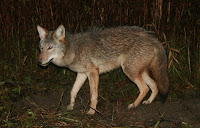
"The thing that I've learned over the years is that urban wildlife behaves completely differently from their rural counterparts," Anchor said. "They have much different strategies for survival than their rural counterparts. There is very little written about it. It's all new."
(Readers may recall a coyote finding its way into a Quiznos a couple of years back in downtown Chicago.)
Anchor started with the forest preserve district as a naturalist in 1981 while still in school at the University of Illinois. His job entailed helping with outdoor education programs for the general public.
In 1987, two years after graduating, he became chief wildlife biologist -- a job that "had never existed before," Anchor said. "They actually offered it to four other people who didn't want it, and then they gave it to me. My interests have always been varied, and I thought it was a great opportunity."
The position has evolved over the years.
"When I first started it was a lot of, 'What do we have and where do we have it?'" Anchor said. "Now it's much more disease oriented. It's much more: 'What diseases do we have and where do we have them?'"
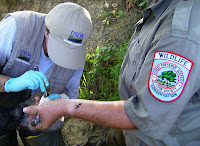
This disease work (in photo to the right, a bird is checked for avian influenza; below, a blood draw is done on a little brown bat) helps keep an eye on wildlife ailments that can be transmitted to humans.
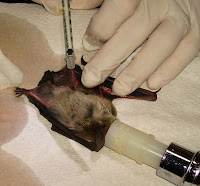
"We use animals as bio monitors," said Anchor. "We collect blood and tissue samples from them. We work closely with public health departments to provide them with information about the prevalence or presence of diseases, particularly new diseases that have come onto the landscape that are communicable to humans."
Speaking of humans, they are what can make his job, well, let's say challenging.
Animal rights activists are not always enamored with the way wildlife professionals operate, and Anchor has fielded the occasional death threat, he acknowledged.
Anchor doesn't want to get too specific about what has rankled different people, but said, "Anytime you handle an animal in an urban setting, you've got a very small group of people that think you're a saint, and another very small group of people that think you're Satan reincarnate."
That was evident when a wild cougar slinked its way into Chicago, and ended up being shot and killed by a Chicago cop. Some animal rights activists were enraged, and Mayor Daley received a threatening note after defending the shooting -- and an arson fire near his Michigan vacation home was believed to be connected as well to the incident.
Anchor has come to be known as a real expert on the natural world in Chicago and its environs, and he's often sought out by reporters looking for a knowledgeable source on wildlife (even a painted turtle, shown below.)
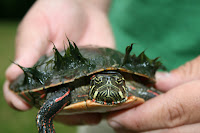
"Chris is knowledgeable about pretty much anything that's out there," said Chris Merenowicz, assistant director of the forest preserve district's resource management department. "Whether it's a plant or a deer, he knows where they're at, what they're supposed to be doing, and what they're not supposed to be doing. He's the 'go to guy.'"
And Anchor is just plain resilient, Merenowicz said, recalling a project they worked on together.
"One of the big projects that we did together was the Skokie Lagoons fisheries rehabilitation back in the early '90s," Merenowicz said.
"We worked on this thing for three weeks straight without any days off. . . . We could go three or four days in a row without sleep. . . . That's the kind of thing that makes him one of the top guys on the scene because of that work ethic and that tenacity to get things done."
By Lindsey Malkus, for ChicagoWildlifeNews
Contact: [email protected]
Photos courtesy of Cook County Forest Preserve District

0 comments: